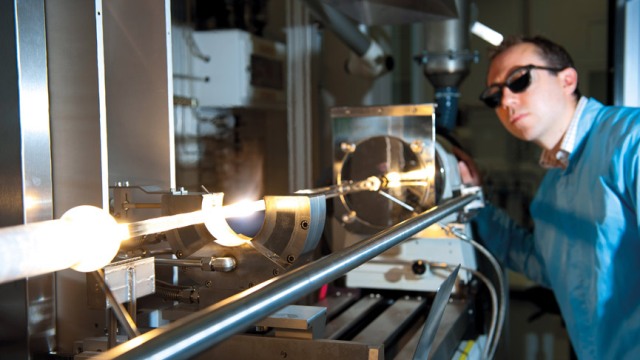Nov 28 2015
Engineers at the University of Sheffield will be combining their expertise with researchers at the University of Southampton on one of two £10 million research centres that will transform the UK’s manufacturing industries through the use of photonics, the science and technology of light.
 Production of an optical fibre on a silica lathe
Production of an optical fibre on a silica lathe
The Engineering and Physical Sciences Research Council (EPSRC) National Hub in High Value Photonic Manufacturing was announced by Universities and Science Minister Jo Johnson.
Photonics manufactures the critical components inside our mobile phones and enables the internet and the optical storage technologies that underpin the digital world. It helps manufacture cars, navigates airliners probes individual human cells and helps defend the nation.
Led by the University of Southampton’s Optoelectronics Research Centre (ORC) together with the ESPRC National Centre for III-V Technologies at the University of Sheffield, the Future Photonics Hub will provide national leadership in manufacturing for the next-generation of photonics technologies. With more than 40 companies providing guidance and resources, the new Hub is solidly focused on improving UK manufacturing efficiency.
The Future Photonics Hub, which is funded for seven years, will accelerate growth of the UK’s £10 billion photonics industry and support the £600 billion of UK manufacturing output that depends on photonics. It will be the go-to place for the UK photonics industry by:
- improving existing manufacturing processes for production of photonics components
- supplying prototypes and sub-systems to their designs
- being a one-stop-shop for trialling user ideas and developing new manufacturing processes.
Hub lead, Professor Sir David Payne, Director of the ORC, said: “The ORC has been at the forefront of photonics for over 40 years. We know from experience the astonishing range of innovative ideas that emerge when scientists and engineers think about manufacturing. The key is to work with industry to understand the opportunity not only to improve existing manufacturing methods but to develop entirely new ways of making things.”
Professor Jon Heffernan, Director of the EPSRC National Centre in Sheffield and deputy Director of the Hub, added: “With our combined expertise and track record in semiconductor epitaxy, lasers, detectors, fibres, and new material platforms, we have a huge opportunity to transform photonics manufacturing in close collaboration with our industrial partners.”
The primary economic impact of the Hub will be to aid rapid commercialisation of emerging technologies. This will result in new products and services in both the photonics industry and in the industries enabled by photonics.
Supporting companies across the UK have so far promised a total of £12.5 million in markets that include defence and security, communications, space, semiconductor manufacturing and healthcare.
The investment in the Future Photonics Hub by EPSRC will be further enhanced by £3 million from the two universities.
Jo Johnson, Minister of State for Universities and Science, said: “From cars to smartphones our world-leading research drives innovation and growth in the UK’s manufacturing industries. With this investment, these new manufacturing hubs will develop the next generation of high tech products in communications and healthcare, as well as tackle industry challenges such as rising materials costs.”
The University of Sheffield has hosted the EPSRC National Centre for III-V Technologies for over 35 years and has developed world-leading research in lasers, quantum devices, detectors, and novel semiconductor materials. The Sheffield-led centre comprises a consortium of Universities including Glasgow, Cambridge and Nottingham. www.epsrciii-vcentre.com
Over five decades, the ORC has maintained a position at the forefront of photonics research. Its long and well established track record in the fields of optical fibre, lasers, waveguides, devices and optoelectronic materials has fostered innovation, enterprise, cross-boundary and multi-disciplinary activities.